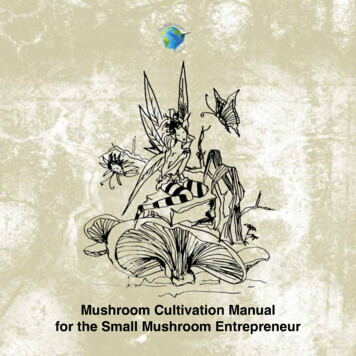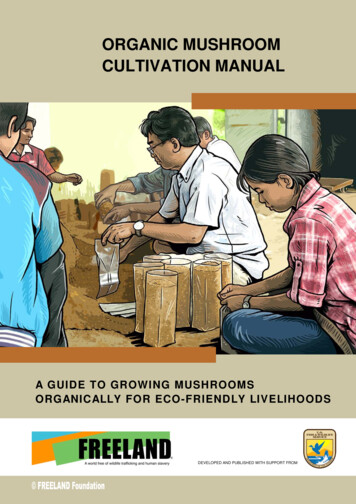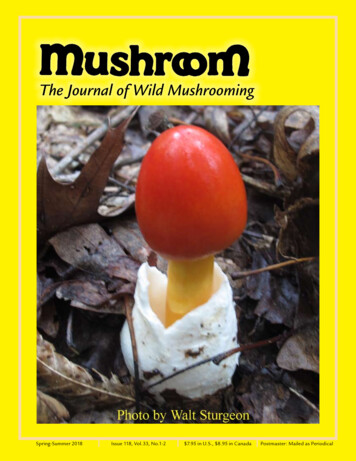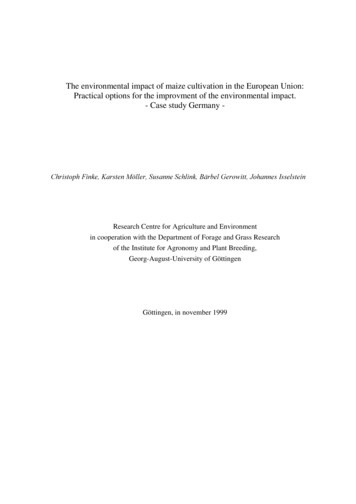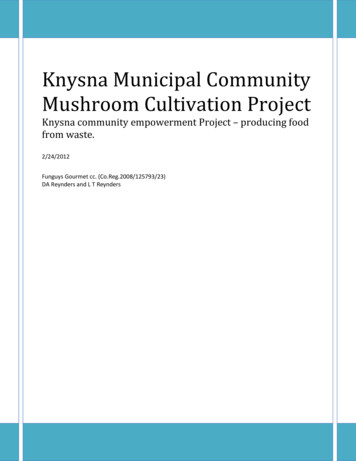
Transcription
Knysna Municipal CommunityMushroom Cultivation ProjectKnysna community empowerment Project – producing foodfrom waste.2/24/2012Funguys Gourmet cc. (Co.Reg.2008/125793/23)DA Reynders and L T Reynders
ForewordIt is my intention with this document to outline a low budget formula, for the production ofOyster Mushrooms from Waste Barley Grain, Waste Paper and Grasses. The mushroom growfacility outlined in this paper is designed to be environmentally friendly, energy efficient andsustainable.The Project is outlined in stages: Phase 1 will deal with Planning, Site Location and Construction of the Grow Facility.Phase 2 will deal with CostingPhase 3 will deal with Production of Mushrooms.Phase 4 will deal with Distribution and Marketing.Phase 5 will deal with Expansion and Progression.Funguys Gourmet cc. (Co.Reg.2008/125793/23)1
Phase 1 - Planning, Site Location andConstruction of the Grow FacilityPlanning:Planning the Project is by far the most time consuming activity in the process, but by takingcare in weighing up all the options, the pros and the cons, the scope and intention we hope fordecisive and consistent results. Planning for the economical tides that we locally andinternationally may experience over the next couple of years as well as planning ahead forenergy saving and efficiency is of utmost importance. Planning your project to be Green willhave positive effects on your local economy. Planning ahead where you will find yoursubstrates, what containers you will use to grow your mushrooms in and what waste productsyou yourself will produce is all part of this planning phase.Scope:1) What type of mushroom will grow well naturally in our environment and may very wellbe part of our local ecosystem?2) Can I produce this mushroom through the year?3) What does the mushroom need to thrive?4) Planning the budget.5) Consider financial increases of production cost.6) Consider increases in energy charges.7) Consider water usage and saving.8) Consider what waste material you will produce and how you could recycle your ownwaste in a secondary productive process.9) Negotiating with local businesses to supply you with substrate materials e.g. some typesof garden refuse, waste barley grain from the local brewery, municipal grass clippingsand paper from the paper recycling depot.10) Negotiating with some local businesses or local government to sponsor or donate to theongoing project e.g. shipping containers.11) Consider the scope of expanding the project.12) Planning a training manual for all staff.13) Health and safety procedures.14) Pest control.Funguys Gourmet cc. (Co.Reg.2008/125793/23)2
Site Location:Ideally you would like a site in the mountains with a crystal water stream flowing past yourgrow facility. In our world today this is becoming further and further away a possibility, so wechose to look at what we have.Scope:We need access to clean de-chlorinated water;Easy access to the substrates that will be used;Relatively clean air – low contamination levels from external sources;North facing roof structure for solar equipment;Easy access to market your product locally;Accessible to Workforce;Access to space outdoors for composting and Vermicast production (Secondary process- mushroom production);8) Access to Cleaning facilities, toilets, change room for staff;9) Access to Clean – SABS049 Standard – Packing facility;10) Accessibility of existing rain water tanks will be beneficial;1)2)3)4)5)6)7)Construction of the Grow facility:There is a large sum of work to consider as well as intense planning before building yourmushroom grow-facility. As an example I will consider using an empty factory space in theKnysna Industrial area and that the entire grow facility will fit within this factory space. Threemain Zones must be created within this factory. Zone 1 is a public space, for administration,reception, deliveries etc. Zone 2 is separated from Zone 1 and will be used for cleaning,showering, have toilets and a changing room. Zone 3 is separated from Zone 2 and will housethe mushroom factory. The following section will focus on Zone 3.Funguys Gourmet cc. (Co.Reg.2008/125793/23)3
Diagram 1Funguys Gourmet cc. (Co.Reg.2008/125793/23)4
Step 1a) Build the pasteurization chamber. Use a stainless steel pasteurizer, 210 Lt Drum orcement mixer. Depending on the method used you will need some way to extract thesubstrate after sterilization. The wet substrate could get quite heavy when soaked andyou will need a mechanical chain lift to remove the substrate. This step must beconsidered and pre planned for in Phase 1.b) The preparation and pasteurization area must have a concrete floor, and have a drain toeasily dispose of excess water.c) Natural Gas is used in part of the pasteurization process and must be kept away fromflammable equipment.d) Solar heated water will be ideal to use in the production facility for pasteurization andwashing up.e) A Suitable method must be found to allow your substrate to cool, away from insects andout of air draft. It is important to keep your sterilized substrate clean at this time toavoid later contamination that will spoil your harvest.f) Easy access to the inoculation chambers.Step 2a) The Inoculation Chambers must be a semi-sterile space that is only used for the purposeof inoculating your mushroom bags. Before and after each inoculation session, the roommust be pressure washed and sterilized using Des-O-Germ . (This is an environmentallyfriendly product that can be used in Myco culture.) To accomplish this, the floor must becemented and slanted slightly for easy drainage.b) It is customary to use a laminar flow hood in your inoculation chambers, but for astartup project, it will be possible to go without (Pleurotus Ostreatus – OysterMushrooms is a very hardy and aggressive culture).c) The inoculation chambers will need a fresh air inlet – sterilize the air using a 3-micronHEPA filter.d) A large stainless steel surface is needed to handle your substrate.e) The inoculation chambers must have a basin and water tap for hand washing.f) The inoculation chambers must be fitted with a hand towel dispenser as well asequipped with a clean cupboard for sterile overalls.g) It will be useful to have a door leading from the inoculation chambers to the Nursery foreasy transfer of inoculated bags.Funguys Gourmet cc. (Co.Reg.2008/125793/23)5
Step 3a) The Nursery is the space where inoculated bags are left to mature before fruiting. Lightis omitted completely during this stage.b) A Cement well drained floor is preferable to aid easy cleaning.c) The room must be air tight to keep out insect and contaminants.d) The Nursery will need a fresh air inlet – sterilize the air using a 3-micron HEPA filter.e) The room must be fitted with racks to keep the bags off the floor.f) This room must be fitted with a thermostat and wall heating unit to automatetemperature variations.Step 4a) The mushroom fruiting space will take the larger part of the factory.b) For the purpose of this project I will consider an open plan grow space. (Diagram 1)c) The floor will be constructed from cement for easy cleaning. It can be covered witheither a fine gravel or Pine/Blue-Gum wood chip that can be obtained from the localindustry. This will act as deterrent for snails and have a humidification effect as well.Consideration must be taken for the quality of wood chip as this could be a source ofcontamination and may have to be treated with Des-O-Germ from time to time tocombat Trichoderma (a green mold fungi that often occur on decaying wood matter, isfound all over the Garden Route, and will be the main contaminant to avoid ).d) Humidification can be done with high pressure and agricultural misting nozzlessuspended high above the bags. It is important to create a fine mist and not have bigdrops of water settle or drip on the developing and adult mushrooms.e) The wall separations can be constructed from treated wood and greenhouse plasticsheeting and Isotherm. The construction must me sturdy.f) Mushrooms need light, if the factory roof does not have sufficient sky lighting available,lighting will have to be provided.g) Fresh air inlets must be provided to the grow space as developing mushrooms producetremendous amounts of carbon dioxide, and this gas must be removed from the space.h) Entry points to the grow space must be screened doorways to deter flying insects fromentering. The cause of most of contamination in my experience is when the mushroomfly makes an appearance in your grow room. From observing these little flies, I noticedthat they farm and reproduce these molds the same way termites farm mushroommycelium underground - termitomyces.i) Easy access from the grow rooms to the exterior of the factory must be created, forremoval of spent substrate and if any contaminated mushroom bags.Funguys Gourmet cc. (Co.Reg.2008/125793/23)6
Step 5a) The Sorting / Packing Room must be airtight and well screened from insects and otherpests.b) The room must be well ventilated and have a good light source.c) There must be a basin and fresh water tap. (SABS049)d) The floor must be tiled and have a proper drainage for easy cleaning. (SABS049)e) The Sorting / Packing Room need be equipped with disposable hand toweling;f) Off the floor storage of packaging containers; (SABS049)g) Stainless steel working surface;h) Harvesting and processing tools;i) A Calibrated measuring scale.Step 6a) Post processing – Refrigerated chambers to keep spawn and mushrooms.b) Drying facility to dry mushrooms.Step 7a) Spent substrate bags can be emptied outdoors in a designated area.b) The spent substrate can be turned into rich compost using earthworms and beneficialsoil bacteria.c) A Shade netted area will be sufficient.Funguys Gourmet cc. (Co.Reg.2008/125793/23)7
Phase 2 – CostingThere is some specialized equipment not included: Herewith the basic Costs Only.Basic Monthly Costsrental - site specifictelephoneelectricity - availabilitywater - availabilityPest ControlMushroom SpawnLabor55006002000115792016135Labor - Basic3 People79207920Grow Facility - Setup CostPrep and Steam RoomInoculation RoomNurseryGrow Room 1,2,3Solar Water SystemAir & FiltrationProfessional Services390019500112003760094006000300087600Prep and Steam RoomGas Equipment & FittingsPasteurization EquipmentBuckets & Lids500100024003900Inoculation RoomStructure / If not availableLaminar Flow Hood / recommendedFresh Air Inlet - Spigots and air pipesStainless Steel Table50001000012002000Funguys Gourmet cc. (Co.Reg.2008/125793/23)8
Paper Toweling cksAir inlet & Spigots60004000120011200Grow Room 1,2,3Structure X 3Fresh Air inlets & SpigotsWatering system Lighting2000036008000600037600Professional ServicesElectrical Costs - WiringPlumbing Costs150015003000Solar Water System1 Pump3 X 70W Solar Voltaic Panels2 X 105 ah Batteries1 X ControllerWiring250025002400100010009400Grow Rooms will have a capacity to hold 216 BagsProductionBagsAverage WeightBiological Efficiency2165 kg30%Total Yield Over Two weeks324 kgPrice Per Kilo Of Oyster MushroomsFunguys Gourmet cc. (Co.Reg.2008/125793/23)9
Kilogram Price90 RTotal Projected income over 14 days cycle29160 RTotal Projected income over next 14 days cycle14580 RTotal Projected income over next 14 days cycle7290Total Income over three cycles43740Certain Costs are occurred every cycle to produce 216 BagsTubingCalsium 4002007760At a spawning Rate of 10%Bag weightAmount of BagsTotal Dry WeightSpawn Needed5 kg2161080 kg108The Packaging Room, Lockers for staff, cleaning facilities is not within the costing.Funguys Gourmet cc. (Co.Reg.2008/125793/23)10
Phase 3 – Oyster Mushroom productionGrowth parameters – Winter Oyster Mushroom:[1]Spawn Run:Temperature: 75 F. (24 C.)Relative Humidity: 85-95%Duration: 12-21 daysC02: 5000-20,000 ppmFresh Air Exchanges: 1 per hourLight Requirements: n/aPrimordia Formation:Temperature: 50-60 F. (10-15.6 C.)Relative Humidity: 95-100%Duration: 3-5 daysC02: 1000 ppmFresh Air Exchanges: 4-8 per hourLight Requirements: 1000-1500(2000) lux.*Fruitbody Development:Incubation Temperature: 60-70 F. (10-21 C.)Relative Humidity: 85-90%Duration: 4-7 daysC02: 1000 ppmFresh Air Exchanges: 4-8 per hour.Light Requirements: 1000-1500 (2000) lux.Funguys Gourmet cc. (Co.Reg.2008/125793/23)11
Cropping Cycle:3-4 crops, 7-14 days apart, over 45-55 days.These growth parameters is referenced in Growing Gourmet and Medicinal Mushrooms – Paul StametsSubstrate Selection:Our selection will consist of Grass clippings from both municipal source and garden services;Waste Barley grain from Mitchells breweries; Water Hyacinth can be sourced from local dams(tertiary cleanup project); wheat straw can be added when available; waste paper from localbusinesses and Knysna recycling depot. Substrates may have to be pre dried to some degreebefore use. Long grasses and straw can be chipped to 3- 4 cm pieces. Use only good lookinguncontaminated substrates and remove any substrates that have been contaminated awayfrom the facility.Pasteurization:You will need to keep your substrate submerged in 65 C clean water for 1.5 - 2 hours. Ideally astainless steel milk pasteurization tank would guarantee results, but using a 210L metal tankwould also be sufficient. This process must take place in an area that is draft free and awayfrom any contaminants. Drained water must be funneled to an exterior troth for furthertreatment or use. It is advisable to have this preparation area in close proximity to yourinoculation chambers for easy access. The heated and now sterilized substrate will need to cooldown in a clean space that is out of draft and away from insects. The substrate will take about 3– 4 hours to cool down to below 30 C before inoculation can take place.SpawningIntroducing mushroom mycelium to the sterilized substrate is referred to as spawning orinoculation. It is accomplished by adding seed kernels to the substrate that previously wasimpregnated by the fungi of your choice. The seed spawn kernels are well mixed into the stillmoist and warm spawn and the bagged in 300mm diameter plastic bags or tubs. These bags arethen moved to your Mushroom Nursery.Funguys Gourmet cc. (Co.Reg.2008/125793/23)12
The NurseryThe inoculated bags will heed some time for vegetative growth. By keeping the constanttemperature above 18 C and below 22 C, the bags will be ready for fruiting in 14 – 21 days.During this time light is completely omitted, fresh air is routinely introduced to expel the highamounts of carbon dioxide that will build up in the nursery during this time. The humidity canbe kept between 60 and 70 RHM during this time. Care must be taken to keep the nursery freeof rodents and flying insects. Any contaminated bags can be removed of the premises andcomposted.Since Trichoderma is a common fungal contaminant in the mushroom growing environment,trying to combat the fungi is impossible. The only way to win is by prevention. Trichoderma haseconomic value as well as an additive in commercial Peat production and compost making aswell as a natural pesticide. Trichoderma also seem to show mycorrhizal activity with plant rootsand can improve the general health of plants by activating their host defense response.[2]Growing out the MushroomsOyster mushrooms prefer a temperature of between 10 C and 21 C. The humidity must be kepthigh during the fruiting phase, between 80 and 90 RHM. Plenty of fresh air must be introducedto expel the carbon dioxide buildup and supply oxygen for mushroom growth. If your room is10m in length, 5m wide and 3m high, you will have 150m³ of air to replace 4 – 8 times an hour.Small X cuts, 25mm, are made on the surface of the plastic mushroom grow bag or container tointroduce fresh air to the mushroom mycelium as well as a 12 hour light cycle. The combinationof lowered temperature, light and fresh air will bump the mycelium into its fruiting stage.Within 7 days small pins are formed that will develop into adult mushrooms within 5 days,depending on the ambient room temperature. Cooler air will produce sturdier, bluer in colormushrooms but will take longer to develop. Higher temperatures may produce adultmushrooms from pins within 3 days. These mushrooms tend to be whiter in color and will loseshelf life as they become more fragile.Mushrooms are harvested by turning the clump of mushrooms to either side while holding atthe base of the mushroom stems. After harvest mushrooms must be kept in the cooling facilityat 4 C until processed.Funguys Gourmet cc. (Co.Reg.2008/125793/23)13
Phase 4 – Distribution and MarketingDistribution:Packaging:Packaging of Oyster mushrooms for distribution is specific for product freshness and shelf lifeand is determined by the final retail destination. As the mushrooms continue to give of heatonce they have been harvested and need to breath, packaging that accommodates this isnecessary. There are two options:a) For retail sales at supermarket level the PET clam shell with aeration holes in the base.Unfortunately having customers select their own mushrooms out of a large cardboardbox does not work for the oyster mushrooms due to their delicate structure and rapidproduct degradation would occur. Labeling of the product must be in accordance withthe laws governing such labels.Cost: Clam shell containersR1.14 eaPurchased in volumes of 500Label StickersR1.50 eaPurchased in volumes of 50 or 100b) For bulk orders (in excess of 1 kilo) to restaurants & hotels a cardboard box is mostefficient.Cost: Cardboard boxesR5.95 eaThe dried or ground mushrooms can be packed in re-sealable Doy packs with a sticker label.These present well as they can stand alone or be hung on a display stand. The re-sealable doypack keeps moisture out and a good visual on the product.Distribution:Fresh Oyster mushrooms are best supported by a local market – in this particular case thedistribution range would be from George to Plettenberg Bay, anywhere further would needrefrigerated transport.Hotels Resorts Lodges - Under the auspices of ‘Support Local’ and ‘Naturally Knysna’, theproject would benefit greatly from a years’ support from (at least) 5 Knysnahotels/resorts/lodges having a standing weekly/monthly order (allowing for fluctuations duringoff-peak and peak seasons) The hotels would in turn earn ‘Local Supporter’ credits, have aspecial Local Grown item on their menu and may create awareness for their own brand throughFunguys Gourmet cc. (Co.Reg.2008/125793/23)14
affiliation. The dried and dried-ground mushrooms would also find a market in this sector beingused as vegetarian stock or sauce additive.Community Feeding Scheme – considering the incredible health benefits of the Oystermushroom and the fact that it is a complete protein makes it an ideal food for impoverishedpeople especially in a dried ground form, as a stock. The challenge would be to come up with asystem of barter or trade that is mutually beneficial to the project and the feeding scheme. Adialogue with all role players would be essential.Schools – ‘Grow your own Food’ a project that can be brought into the curriculum at manylevels and to various age groups and study disciplines including the study of fungi, mycelianetworks & microbial interactions. Purchasing grow bags from the project would be relativelyinexpensive – about R35.00 per bag.Purchasing a grow bag is an economical way for a family to provide themselves with freshnutritive food. Education on health benefits and cooking methods will facilitate this process.Markets & Festivals – a great opportunity for education, outreach & promotion as well asoffering fresh mushroom sales & food dishesSupermarkets – unfortunately opportunity is extremely limited here due to the retail outletspolicies on food standard auditing and a general closed door policy to supporting localproducers.Restaurants – an extremely fickle market. Very few local restaurants can order and maintainquantities of Oyster mushrooms due to the fluctuations in customer base and cyclical menuchanges. There also appears to be a certain amount of ignorance regarding preparation &cooking methods. Ultimately it is the bottom line – cost – and that is where the buttonmushroom, at R45.00 per kilo comes in at half the price of Oyster mushrooms.Marketing:Markets & Festivals are essential for creating branding awareness, customer interaction andeducation on the many aspects of mushroom cultivation and end product use.Funguys Gourmet cc. (Co.Reg.2008/125793/23)15
Phase 5 – Expansion and ProgressionExpansion and Progression:Planning for expansion and progression is not within the scope of this document, therefore Iwill mention only a few things: Planning to move towards energy efficiency takes a substantialoutlay, but will return the investment over and over again in time. Certain specializedequipment will be needed in the future e.g. laminar flow hood to ensure successfulpropagation. Training is essential to the success of a mushroom project.Funguys Gourmet cc. (Co.Reg.2008/125793/23)16
References:[1]Growing Gourmet and Medicinal Mushrooms – Paul .edu/pathogens/trichoderma.htmlFunguys Gourmet cc. (Co.Reg.2008/125793/23)17
b) It is customary to use a laminar flow hood in your inoculation chambers, but for a startup project, it will be possible to go without (Pleurotus Ostreatus - Oyster Mushrooms is a very hardy and aggressive culture). c) The inoculation chambers will need a fresh air inlet - sterilize the air using a 3-micron HEPA filter.
